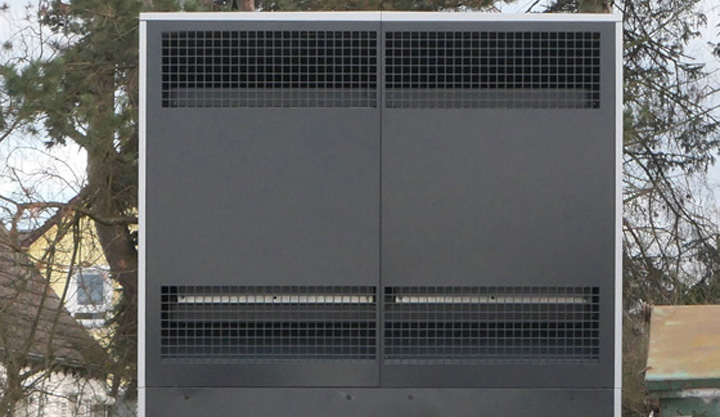
Avoid noise from heatpump outdoor
Helpful guide for private builders
The Bavarian State Office for the Environment (LfU) has published a guide to dealing with noise problems caused by the installation of air-source heat pumps in private houses. In this connection the authority examined individual components of a heat pump regarding noise. Fans are not the only source of noise, but they are responsible for ninety percent of noise problems. During the preparation of the guide, it also came to light that there are considerable differences in the quality of individual products in terms of noise. After all, if all components of an air-source heat pump are optimized in terms of noise, the sound power level should be no more than 50 dB(A). In fact, however, the sound level of equipment on the market can be 70 dB(A) and above.
Finding the optimum fan speed
As mentioned above, fans are often the main source of sound, but the compressor, piping, air ducts, or vibrating cladding panels can also generate unwanted sound. For air-source heat pumps installed outdoors, usually only the radiated airborne sound is important, while for heat pumps installed indoors, both airborne and structure-borne sound must be considered. The main factor influencing fan noise is the volume flow and thus the speed. If the speed is halved, the noise level is reduced by between 15 dB(A) and 18 dB(A). The following rule of thumb can be remembered: the sound power level increases by approx. 0.25 dB(A) per 1% increase in speed. If larger fans are used, a higher volume flow can be achieved at a lower flow velocity. The undesirable side effect is then a larger blade diameter, which in turn can cause higher sound levels. In the best case, size, speed, discharge pressure and volume flow should be matched to find the point for minimum noise generation. The fan should sit in a stable housing and be firmly mounted to prevent imbalances, and must also be acoustically decoupled.
Acoustically optimize air ducts
Air zones with flow and pressure fluctuations occur at suspensions and guard grilles where the fan blades pass, which can cause regular pressure pulses and thus generate a sound-containing noise. The use of angular duct baffles has positive effects on sound insulation, because it prevents unimpeded flow through the air duct in the longitudinal direction. Absorbent liners and a favorable air duct design also provide better sound insulation. Experience has shown that duct bends, cross-section jumps, ventilation grilles and other flow obstacles are critical points in the air ducts. As a basic rule, a low-vorticity flow should prevail in the ventilation duct. Differences of more than 20 dB(A) can also occur at duct components, such as the weather louvers. There are various design options here, the guidebook explains. Air duct plates should be mounted decoupled from the sources of structure-borne noise and vibrating plates should be “de-drilled”.
Silencers in the supply and exhaust air openings
The sound emitted is thus significantly reduced. There are various versions of silencers, e.g. splitter silencers or cylindrical absorption silencers. Another type is the relaxation silencer. The acoustic effect is created by a combination of absorption and reflection in the silencer housings. However, internals must be provided for this purpose. To avoid low frequencies, resonator silencers tuned to the low-frequency hum of the compressor or the fan sound are suitable if the air shafts are large enough. At the specified frequency, the silencer is excited to vibrate and thus dampens the vibrations with a kind of mass-spring system. The interaction between a cavity and a moving air mass is decisive here.
Careful installation of piping
Care must be taken with screwed connections to ensure that no sound bridges are created. A screw that is too tight can render the elastic bearing ineffective. So-called compensators can be inserted into outgoing pipes for decoupling. These are flexible hoses bent through 90° to 360°. The cables should be elastically supported or suspended. Penetrations through the housing must also be absolutely soundproof.
Heat pumps can be enclosed
Sound reduction is possible by complete and joint-tight enclosure. Absorbent material must be introduced into the enclosure, otherwise the sound in the enclosure would actually be amplified. In this case, too, penetrations must be sealed off soundproof. The supply and exhaust air openings must also be fitted with adequately dimensioned silencers. The transmission of structure-borne sound is avoided or reduced if the capsule itself is elastically connected to the foundation.
The complex issue of sound insulation often overwhelms building owners
There are many ways to ensure low-noise operation of an air-source heat pump. Not only in the manufacture, but also in the installation of the system, the sound insulation must be “just right”. Otherwise, trouble with the neighbors is inevitable. If the buildings are close together in a residential area and the sound insulation is poor, the immission guide values of the “Technical Instructions on Noise” (Germany) are quickly exceeded. Subsequent noise abatement measures are usually time-consuming and expensive. The installer should be able to explain the noise control concept plausibly and have a comprehensive checklist ready.
More information
www.lfu.bayern.de/laerm/gewerbe_anlagen/luftwaermepumpen/doc/tieffrequente_geraeusche_teil3_luftwaermepumpen.pdf (German language)
